网上的数据和信息无穷无尽,如今人人都用百度谷歌来作为获取知识,了解新鲜事物的首要信息源。所有的这些网上的信息都是直接可得的,而为了满足日益增长的数据需求,我坚信网络数据爬取已经是每个数据科学家的必备技能了。在本文的帮助下,你将会突破网络爬虫的技术壁垒,实现从不会到会。
大部分网上呈现的信息都是以非结构化的格式存储(html)且不提供直接的下载链接,因此,我们需要学习一些知识和经验来获取这些数据。
本文我将带你领略利用R做网络数据采集的全过程,通读文章后你将掌握如何来使用因特网上各位数据的技能。
目录
- 什么是网络数据爬取
- 为什么需要爬取数据
- 数据爬取方法
- 前提条件
- 使用R爬取网页
- 分析从网页爬取的数据
网络爬虫是讲呈现在网页上以非结构格式(html)存储的数据转化为结构化数据的技术,该技术非常简单易用。
几乎所有的主流编程语言都提供了网络数据爬取的实现方式,本文我们会用R来爬取IMDB上2016年最热门电影的一些特征。
我们将采集2016年度最热门电影的若干特征,同时我们也会遇到网页代码不一致的问题并将其解决。这是在做网络爬虫时最常遇到的问题之一。
如果你更喜欢用python变成,我建议你看这篇指南来学习如何用python做爬虫。
2. 为什么需要爬取数据
我确信你现在肯定在问“为什么需要爬取数据”,正如前文所述,爬取网页数据极有可能。(译者注:原文如此,我没看懂这个设问的逻辑)
为了提供一些使用的知识,我们将会爬取IMDB的数据,同时,利用爬虫你还可以:
- 爬取电影评分来构建推荐系统
- 爬取维基百科等信源的文本作为训练预料来构建深度学习模型以实现主体识别等功能
- 爬取有标签的图像(从Google,Flickr等网站)来训练图像分类模型
- 爬取社交媒体数据(Facebook 和 Twitter 等)做情感分析,观点挖掘等
- 爬取电商的用户评论和反馈(从Amazon,Flipkart等)
网络数据抓取的方式有很多,常用的有:
- 人工复制粘贴:这是采集数据的缓慢但有效的方式,相关的工作人员会自行分析并把数据复制到本地。
- 文本模式匹配:另一种简单有效的方法是利用编程语言中的正则表达式来匹配固定模式的文本,在这里你可以学到关于正则表达式的更多内容。
- 使用API:诸如Facebook,Twitter和Linkedin一类的许多网站都提供了公共或者私人的API,它们提供了标准化的代码供用户请求规定格式的数据。
- DOM解析:程序可以使用浏览器来获取客户端脚本生成的动态内容。基于这些程序可以获得的页面来使用DOM树来解析网页也是可行的办法,
我们会使用DOM解析的方式来获取数据,并基于网页的CSS选择器来寻找含有所需信息的网页部分。但在开始之前,我们必须满足一些前提条件。
4. 前提条件
利用R实现网络爬虫的前提条件有两大块:
- 要写R语言爬虫,你对R必须有一定了解。如果你还是个新手,我强烈建议参照这个学习路径 来学习。本文将使用“Hadley Wickham(Hadley我爱你!!!)”开发的“rvest”包来实现爬虫。你可以从这里获得这个包的文档。如果你没有安装这个包,请执行以下代码。 install.packages('rvest')
- 除此之外,HTML,CSS的相关知识也很重要。学习他们的有一个很好的资源。我见识过不少对HTML和CSS缺乏了解的数据科学家,因此我们将使用名为Selector Gadget的开源软件来更高效地实现抓取。你可以在这里下载这个工具包。请确保你的浏览器已经安装了这个插件(推荐用chrome浏览器),并且能正常使用。(译者注:chrome中的css viewer 和 xpath helper 也是神器。)

使用这个插件你可以通过点击任一网页中你需要的数据就能获得相应的标签。你也可以学习HTML和CSS的知识并且手动实现这一过程。而且,为了更深入地了解网络爬取这一艺术,我很推荐你学习下HTML和CSS来了解其背后的机理。
5. 使用R爬取网页
现在让我们开始爬取IMDB上2016年度最流行的100部故事片,你可以在这里查看相关信息。
# 加载包library('rvest')# 指定要爬取的urlurl <- 'http://www.imdb.com/search/title? count=100&release_date=2016,2016&title_type=feature'# 从网页读取html代码webpage <- read_html(url)
现在,让我们爬取网页上的这些数据:
- Rank:从1到100,代表排名
- Title:故事片的标题
- Deion:电影内容简介
- Runtime: 电影时长
- Genre: 电影类型
- Rating: IMDB提供的评级
- Metascore: IMDB上该电影的评分
- Votes: 电影的好评度
- Gross_Earning_in_Mil: 电影总票房(百万)
- Director: 影片的总导演,如果有多位,取第一个
- Actor: 影片的主演,如果有多位,取第一个
这是页面的截图
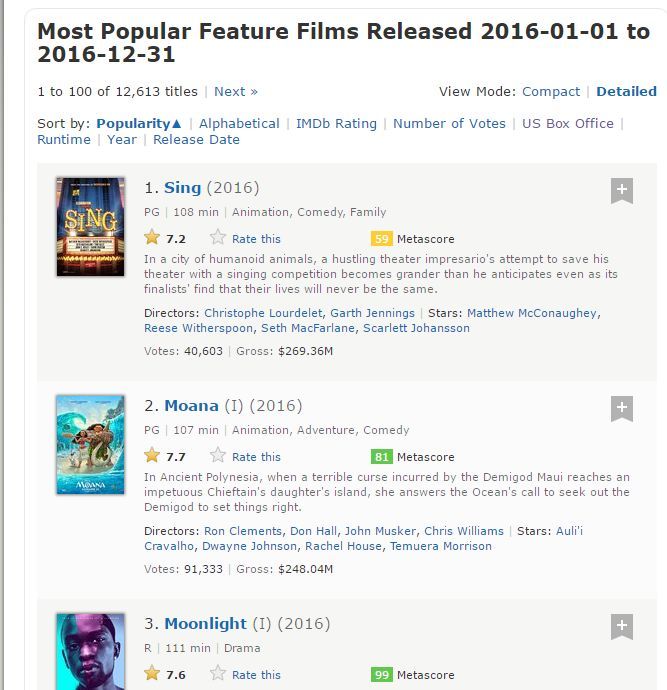
Step 1:爬取的第一步是使用 selector gadget获得排名的CSS选择器。你可以点击浏览器中的插件图标并用光标点击排名的区域。

要确保所有的排名都被选择了,你也可以再次点击选中区域来取消选择,最终只有高亮的那些部分会被爬取。
Step 2:一旦你已经选择了正确的区域,你需要把在底部中心显示的相应的CSS选择器复制下来。
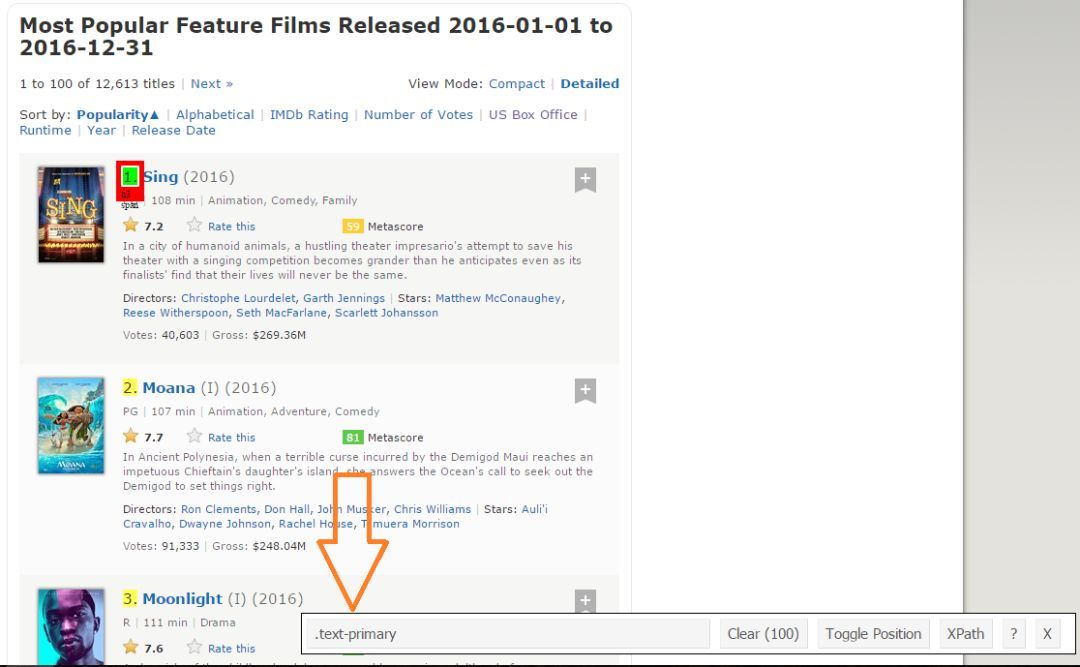
Step 3:只要CSS选择器包含排名,你就能用几行简单的代码来获取所有的排名了:
# 用CSS选择器获取排名部分rank_data_html <- html_nodes(webpage,'.text-primary')# 把排名转换为文本rank_data <- html_text(rank_data_html)# 检查一下数据head(rank_data)[1] "1." "2." "3." "4." "5." "6."
Step 4:获取数据之后,请确保他们被你所需的格式存储,我会把排名处理成数值型。
# 数据预处理:把排名转换为数值型rank_data<-as.numeric(rank_data)# 再检查一遍head(rank_data)[1] 1 2 3 4 5 6
Step 5:现在你可以清空选择部分并开始选择电影标题了,你可以看见所有的标题都被选择了,你依据个人需要做一些增删。
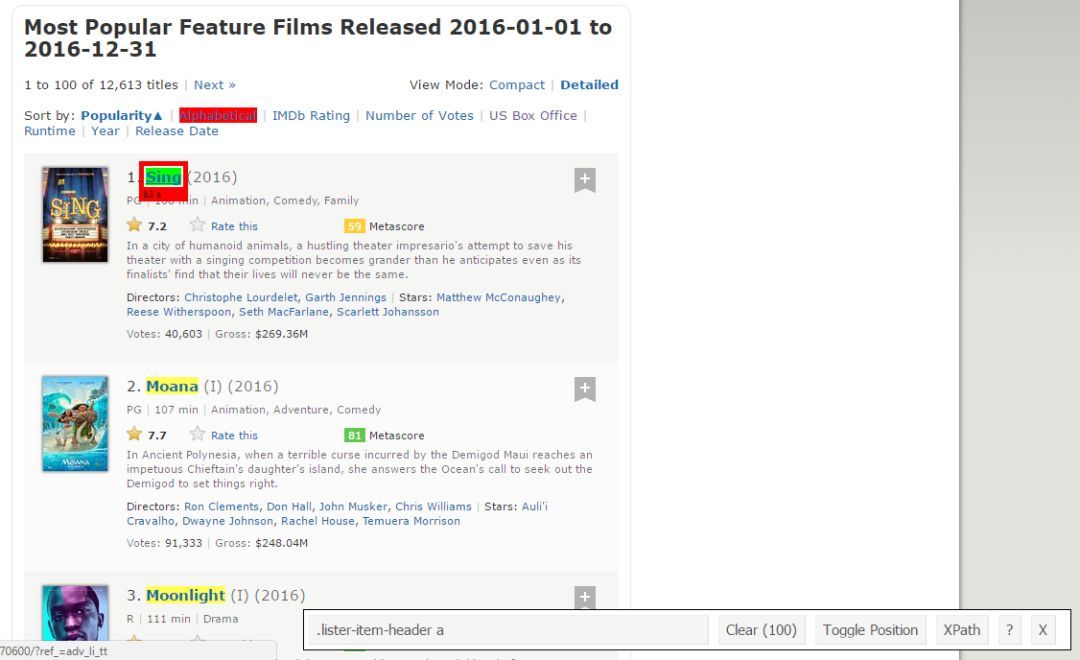
Step 6:正如从前,再次复制CSS选择器并用下列代码爬取标题。
# 爬取标题title_data_html <- html_nodes(webpage,'.lister-item-header a')# 转换为文本title_data <- html_text(title_data_html)# 检查一下head(title_data)[1] "Sing" "Moana" "Moonlight" "Hacksaw Ridge"[5] "Passengers" "Trolls"
Step 7:下列代码会爬取剩余的数据– Deion, Runtime, Genre, Rating, Metascore, Votes, Gross_Earning_in_Mil , Director and Actor data.
# 爬取描述deion_data_html <- html_nodes(webpage,'.ratings-bar+ .text-muted')# 转为文本deion_data <- html_text(deion_data_html)# 检查一下head(deion_data)[1] "nIn a city of humanoid animals, a hustling theater impresario's attempt to save his theater with a singing competition becomes grander than he anticipates even as its finalists' find that their lives will never be the same."[2] "nIn Ancient Polynesia, when a terrible curse incurred by the Demigod Maui reaches an impetuous Chieftain's daughter's island, she answers the Ocean's call to seek out the Demigod to set things right."[3] "nA chronicle of the childhood, adolescence and burgeoning adulthood of a young, African-American, gay man growing up in a rough neighborhood of Miami."[4] "nWWII American Army Medic Desmond T. Doss, who served during the Battle of Okinawa, refuses to kill people, and becomes the first man in American history to receive the Medal of Honor without firing a shot."[5] "nA spacecraft traveling to a distant colony planet and transporting thousands of people has a malfunction in its sleep chambers. As a result, two passengers are awakened 90 years early."[6] "nAfter the Bergens invade Troll Village, Poppy, the happiest Troll ever born, and the curmudgeonly Branch set off on a journey to rescue her friends.# 移除 'n'deion_data<-gsub("n","",deion_data)# 再检查一下head(deion_data)[1] "In a city of humanoid animals, a hustling theater impresario's attempt to save his theater with a singing competition becomes grander than he anticipates even as its finalists' find that their lives will never be the same."[2] "In Ancient Polynesia, when a terrible curse incurred by the Demigod Maui reaches an impetuous Chieftain's daughter's island, she answers the Ocean's call to seek out the Demigod to set things right."[3] "A chronicle of the childhood, adolescence and burgeoning adulthood of a young, African-American, gay man growing up in a rough neighborhood of Miami."[4] "WWII American Army Medic Desmond T. Doss, who served during the Battle of Okinawa, refuses to kill people, and becomes the first man in American history to receive the Medal of Honor without firing a shot."[5] "A spacecraft traveling to a distant colony planet and transporting thousands of people has a malfunction in its sleep chambers. As a result, two passengers are awakened 90 years early."[6] "After the Bergens invade Troll Village, Poppy, the happiest Troll ever born, and the curmudgeonly Branch set off on a journey to rescue her friends."# 爬取runtime sectionruntime_data_html <- html_nodes(webpage,'.text-muted .runtime')# 转为文本runtime_data <- html_text(runtime_data_html)# 检查一下head(runtime_data)[1] "108 min" "107 min" "111 min" "139 min" "116 min" "92 min"# 数据预处理: 去除“min”并把数字转换为数值型runtime_data <- gsub(" min","",runtime_data)runtime_data <- as.numeric(runtime_data)# 再检查一下head(rank_data)[1] 1 2 3 4 5 6# 爬取genregenre_data_html <- html_nodes(webpage,'.genre')# 转为文本genre_data <- html_text(genre_data_html)# 检查一下head(genre_data)[1] "nAnimation, Comedy, Family "[2] "nAnimation, Adventure, Comedy "[3] "nDrama "[4] "nBiography, Drama, History "[5] "nAdventure, Drama, Romance "[6] "nAnimation, Adventure, Comedy "# 去除“n”genre_data<-gsub("n","",genre_data)# 去除多余空格genre_data<-gsub(" ","",genre_data)# 每部电影只保留第一种类型genre_data<-gsub(",.*","",genre_data)# 转化为因子genre_data<-as.factor(genre_data)# 再检查一下head(genre_data)[1] Animation Animation Drama Biography Adventure Animation
10 Levels: Action Adventure Animation Biography Comedy Crime Drama ... Thriller
# 爬取IMDB ratingrating_data_html <- html_nodes(webpage,'.ratings-imdb-rating strong')# 转为文本rating_data <- html_text(rating_data_html)# 检查一下head(rating_data)[1] "7.2" "7.7" "7.6" "8.2" "7.0" "6.5"# 转为数值型rating_data<-as.numeric(rating_data)# 再检查一下head(rating_data)[1] 7.2 7.7 7.6 8.2 7.0 6.5# 爬取votes sectionvotes_data_html <- html_nodes(webpage,'.sort-num_votes-visible span:nth-child(2)')# 转为文本votes_data <- html_text(votes_data_html)# 检查一下head(votes_data)[1] "40,603" "91,333" "112,609" "177,229" "148,467" "32,497"# 移除“,”votes_data<-gsub(",", "", votes_data)# 转为数值型votes_data<-as.numeric(votes_data)# 再检查一下head(votes_data)[1] 40603 91333 112609 177229 148467 32497# 爬取directors sectiondirectors_data_html <- html_nodes(webpage,'.text-muted+ p a:nth-child(1)')# 转为文本directors_data <- html_text(directors_data_html)# 检查一下head(directors_data)[1] "Christophe Lourdelet" "Ron Clements" "Barry Jenkins"[4] "Mel Gibson" "Morten Tyldum" "Walt Dohrn"# 转为因子directors_data<-as.factor(directors_data)# 爬取actors sectionactors_data_html <- html_nodes(webpage,'.lister-item-content .ghost+ a')# 转为文本actors_data <- html_text(actors_data_html)# 检查一下head(actors_data)[1] "Matthew McConaughey" "Auli'i Cravalho" "Mahershala Ali"[4] "Andrew Garfield" "Jennifer Lawrence" "Anna Kendrick"# 转为因子actors_data<-as.factor(actors_data)
我时爬Metascore时遇到问题,我希望你能仔细看看。
# 爬取metascore sectionmetascore_data_html <- html_nodes(webpage,'.metascore')# 转为文本metascore_data <- html_text(metascore_data_html)# 检查一下head(metascore_data)[1] "59 " "81 " "99 " "71 " "41 "[6] "56 "# 去除多余空格metascore_data<-gsub(" ","",metascore_data)# 检查metascore data的长度length(metascore_data)[1] 96
Step 8:meta score只有96个数据,可我们却爬取了100部电影。这个问题产生的原型是由4部电影没有Metascore数据。
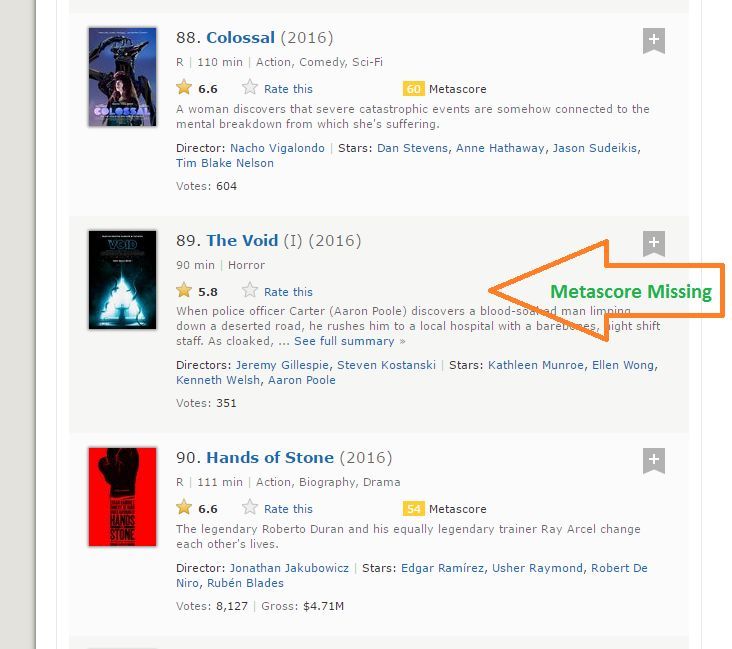
Step 9:这是爬取所有网页都会遇到的常见问题,如果我们只是简单地用NA来填充这四个缺失值,它会自动填充第97到100部电影。通过一些可视化检查,我们发缺失matascore的是第39,73,80和89部电影。我用下面的函数来解决这个问题。
for (i in c(39,73,80,89)){ a <- metascore_data[1:(i-1)] b<-metascore_data[i:length(metascore_data)] metascore_data <- append(a, list("NA")) metascore_data <- append(metascore_data, b)}# 转换为数值型metascore_data <- as.numeric(metascore_data)# 再次检查下长度length(metascore_data)[1] 100# 看看描述性统计量summary(metascore_data)Min. 1st Qu. Median Mean 3rd Qu. Max. NA's23.00 47.00 60.00 60.22 74.00 99.00 4
Step 10:同样的问题也会发生在Gross变量上,我用同样的方式来解决。
# 爬取revenue sectiongross_data_html <- html_nodes(webpage,'.ghost~ .text-muted+ span')# 转为文本gross_data <- html_text(gross_data_html)# 检查一下head(gross_data)[1] "$269.36M" "$248.04M" "$27.50M" "$67.12M" "$99.47M" "$153.67M"# 去除'$' 和 'M' 标记gross_data <- gsub("M", "", gross_data)gross_data <- substring(gross_data, 2, 6)# 检查长度length(gross_data)[1] 86# 填充缺失值for (i in c(17,39,49,52,57,64,66,73,76,77,80,87,88,89)){ a <- gross_data[1:(i-1)] b <- gross_data[i:length(gross_data)] gross_data <- append(a, list("NA")) gross_data <- append(gross_data, b)}# 转为数值gross_data<-as.numeric(gross_data)# 再次检车长度length(gross_data)[1] 100summary(gross_data)Min. 1st Qu. Median Mean 3rd Qu. Max. NA's0.08 15.52 54.69 96.91 119.50 530.70 14
Step 11:.我们已经成功爬取了100部电影的11个特征,让我们创建一个数据框并看看结构。
# 合并所有list来创建一个数据框movies_df <- data.frame( Rank = rank_data, Title = title_data, Deion = deion_data, Runtime = runtime_data, Genre = genre_data, Rating = rating_data, Metascore = metascore_data, Votes = votes_data, Gross_Earning_in_Mil = gross_data, Director = directors_data, Actor = actors_data)# 查看数据框结构str(movies_df)'data.frame' : 100 obs. of 11 variables:$ Rank : num 1 2 3 4 5 6 7 8 9 10 ...$ Title : Factor w/ 99 levels "10 Cloverfield Lane",..: 66 53 54 32 58 93 8 43 97 7 ...$ Deion : Factor w/ 100 levels "19-year-old Billy Lynn is brought home for a victory tour after a harrowing Iraq battle. Through flashbacks the film shows what"| __truncated__,..: 57 59 3 100 21 33 90 14 13 97 ...$ Runtime : num 108 107 111 139 116 92 115 128 111 116 ...$ Genre : Factor w/ 10 levels "Action","Adventure",..: 3 3 7 4 2 3 1 5 5 7 ...$ Rating : num 7.2 7.7 7.6 8.2 7 6.5 6.1 8.4 6.3 8 ...$ Metascore : num 59 81 99 71 41 56 36 93 39 81 ...$ Votes : num 40603 91333 112609 177229 148467 ...$ Gross_Earning_in_Mil: num 269.3 248 27.5 67.1 99.5 ...$ Director : Factor w/ 98 levels "Andrew Stanton",..: 17 80 9 64 67 95 56 19 49 28 ...$ Actor : Factor w/ 86 levels "Aaron Eckhart",..: 59 7 56 5 42 6 64 71 86 3 ...
现在2016年上映的最流行的100部故事片在IMDB上的数据已经爬取成功了!
6. 分析从网页爬取的数据
爬取好数据后,你们队数据进行一些分析与推断,训练一些机器学习模型。我在上面这个数据集的基础上做了一些有趣的可视化来回答下面的问题。
library('ggplot2')qplot(data = movies_df,Runtime,fill = Genre,bins = 30)
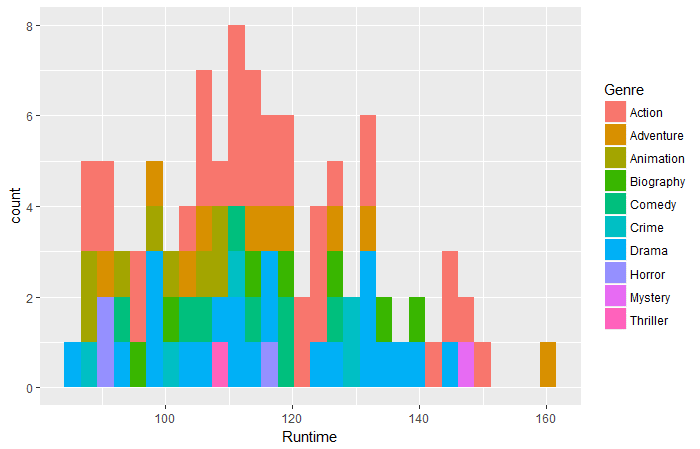
Question 1: 那个类型的电影市场最长?
ggplot(movies_df,aes(x=Runtime,y=Rating))+geom_point(aes(size=Votes,col=Genre))
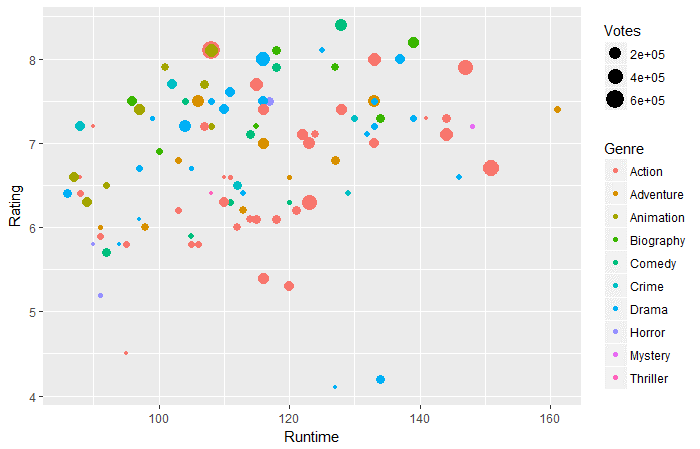
Question 2: 市场130-160分钟的电影里,哪一类型东西好评率最高?
ggplot(movies_df,aes(x=Runtime,y=Gross_Earning_in_Mil))+geom_point(aes(size=Rating,col=Genre))
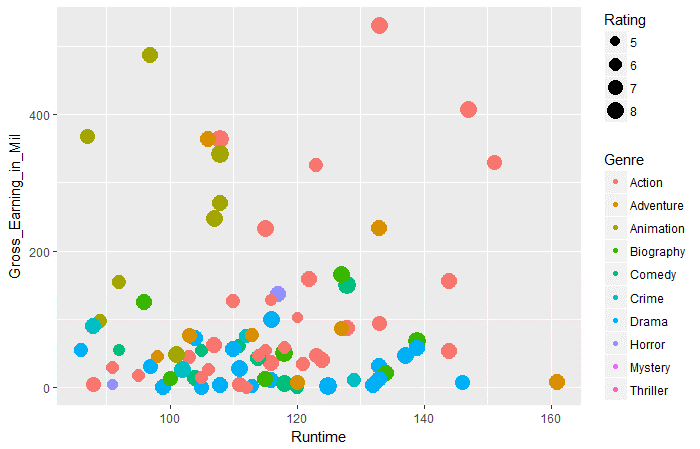
Question 3:100-120分钟的电影中,哪类作品的票房成绩最好
结语
我相信本文会让你对利用R爬取网页有一定了解,你对采集数据过程中可能遇到的问题也有所涉猎了。由于网页上的大部分数据是非结构化的,爬虫真的是非常重要的一项技能。
- 本文固定链接: https://www.maimengkong.com/learn/787.html
- 转载请注明: : 萌小白 2021年10月11日 于 卖萌控的博客 发表
- 百度已收录
